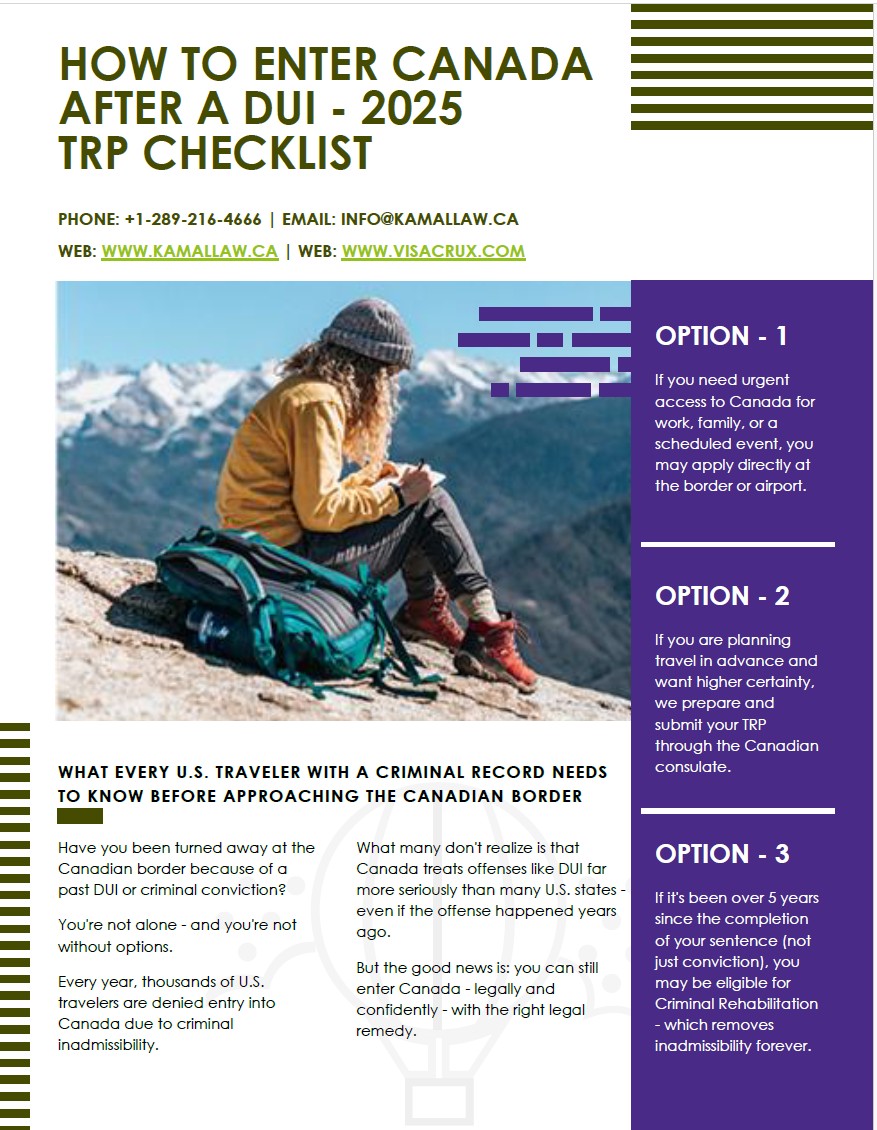Canada Application for Criminal Rehabilitation: Overcoming Inadmissibility
Your Quick 30-Second Answer to Canada application for criminal rehabilitation!
The Canada application for criminal rehabilitation is a legal process that allows individuals with past criminal convictions to overcome criminal inadmissibility and enter Canada. For foreign nationals with foreign convictions, the application process requires proof of completion of your sentence, such as payment of fines, and submission of an application form to the Canadian consulate or Canadian visa office. If five years have passed since your full sentence, you may apply for criminal rehabilitation in Canada as a permanent solution, unlike a temporary waiver. Non-serious crimes may qualify for deemed rehabilitation after a certain period of time, while more serious crimes require a formal application. Ensure your application includes all details of your criminal history, efforts toward rehabilitation (e.g., community service), and strong documentation to create the strongest possible application. Canadian immigration authorities assess factors such as the severity of the offense, and processing time varies, so apply early to avoid issues at the port of entry.
For an in-depth overview, please see the "Table of Contents" below.
Canada Application for Criminal Rehabilitation: How to Apply in 2025
By Kamal Akhtar, Canadian Immigration Lawyer | Last Reviewed: August 17, 2025
1. TRP and Criminal Rehabilitation
2. Temporary Resident Permit (TRP)
3. Criminal Rehabilitation
4. How to Enter Canada with a DUI
5. TRP for DUI (Driving Under the Influence)
6. TRP Checklist 2025 (Free PDF Download)
Download our 2025 TRP Guide & Checklist PDF to make sure you never miss a critical item.

Kamal Akhtar is a Canadian immigration lawyer licensed by the Law Society of Ontario. Based in Ontario, Canada. Kamal has years of experience helping foreign nationals with immigration applications and appeals. He specializes in Canadian immigration law and other complex entry solutions. Kamal dedicates himself to delivering honest, strategic, and client-centered legal solutions for every case.
Phone: +1 (289) 216-4666 | Fax: +1 (289) 778-4745 | Email: info@kamallaw.ca
Welcome! This article will guide you through the Canada application for criminal rehabilitation, explaining how individuals with past convictions can navigate the process to overcome inadmissibility and enter Canada successfully.
TABLE OF CONTENT
1. Introduction and Importance of Criminal Rehabilitation
Topic 1: Introduction: Why Criminal Rehabilitation is Critical
Topic 2: Understanding Criminal Rehabilitation
2. Eligibility and Application Process
Topic 3: Eligibility Criteria for Criminal Rehabilitation
Topic 4: How to Apply for Criminal Rehabilitation
3. Key Considerations and Sentencing
Topic 5: Key Considerations for a Successful Application
Topic 6: Understanding Canadian Sentencing and Offenses
4. Fees, Processing, and Temporary Solutions
Topic 7: Fees and Processing Times
Topic 8: Temporary Resident Permit (TRP) While Awaiting Rehabilitation
5. Legal Support and Success Stories
Topic 9: The Role of Lawyers in the Criminal Rehabilitation Process
Topic 10: Real-Life Stories of Successful Criminal Rehabilitation Applications
6. Conclusion:
Topic 11: How Criminal Rehabilitation Can Change Lives
Topic 12: Frequently Asked Question (FAQs)

1. Topic 1: Introduction: Why Criminal Rehabilitation is Critical
The Canada application for criminal rehabilitation is crucial for anyone with a criminal record seeking to enter or stay in Canada. This process helps foreign nationals with past convictions overcome criminal inadmissibility to Canada, allowing them to visit, work, or obtain permanent residence. If you have committed a crime in a foreign country, you might be considered inadmissible at the Canadian border, which can block you from entering the country. Rehabilitation, however, provides a way to clear this hurdle and is often seen as a lifeline for individuals with prior convictions who want to start fresh in Canadian society.
What is Criminal Inadmissibility?
Criminal inadmissibility means that a person is not allowed to enter Canada due to criminal offenses they have committed outside of Canada. This applies to various offenses, ranging from minor summary offences to serious indictable offences. Canadian law aligns foreign convictions with equivalent offenses under the Canadian criminal code, and even a single offense may lead to inadmissibility.
For example, an individual with a DUI conviction in the United States may be considered inadmissible due to how Canadian immigration authorities view the crime under Canadian law.
Consequences of Being Denied Entry to Canada
If you're denied entry to Canada because of criminal inadmissibility, it could mean missing out on crucial personal or professional opportunities. Individuals traveling for business, tourism, or family visits could face rejection at the port of entry. This can happen to American citizens as well as other foreign nationals. In cases of urgent travel, one might need to apply for a temporary resident permit or seek special permission to enter Canada, but these are temporary solutions compared to the more permanent benefit of criminal rehabilitation.
Topic 2: Understanding Criminal Rehabilitation
The Canada application for criminal rehabilitation is a formal process that allows individuals with foreign convictions to overcome criminal inadmissibility and gain entry into Canada. This process is essential for individuals who wish to enter Canada but are currently barred due to their criminal record. Rehabilitation is a one-time solution that can permanently clear inadmissibility, unlike temporary permits. The process involves applying for individual rehabilitation and providing evidence that the applicant is no longer a threat to Canadian society.
Defining Criminal Rehabilitation in Canada’s Context
Criminal rehabilitation is a legal mechanism under Canadian immigration law that allows those with criminal offenses from a foreign country to be deemed rehabilitated. This applies if the individual can demonstrate that enough time has passed since the completion of their sentence and they no longer pose a risk. The rehabilitation process requires applicants to submit a Canada criminal rehabilitation application, which must be reviewed and approved by a Canadian immigration officer.
For example, someone with a DUI conviction from the United States or a reckless driving offense would need to prove they’ve reformed and are no longer a danger to the public.
Types of Convictions That Require Rehabilitation
Convictions can range from non-serious offenses to more serious crimes. In Canadian terms, offenses are classified as either summary convictions (minor) or indictable offences (serious). The severity of the offense will impact the criminal rehabilitation application process and how long one must wait before applying.
Differentiating Between Non-Serious and Serious Criminality
- Non-serious criminality: Includes offenses like summary offences or misdemeanors that carry lighter penalties. These may qualify for rehabilitation sooner.
- Serious criminality: Includes offenses like felonies or indictable offenses, such as drug trafficking or bodily harm.
A non-serious offence may involve minor crimes, like petty theft or a DUI, where the maximum sentence is less than ten years under Canadian law. In contrast, serious criminality involves crimes like assault with a weapon, where the penalties are harsher. The type of criminal offense will determine eligibility for Canadian rehabilitation and the overall complexity of the criminal rehabilitation process.
Topic 3: Eligibility Criteria for Criminal Rehabilitation
When applying for the Canada application for criminal rehabilitation, meeting specific eligibility criteria is essential. This legal process allows individuals with previous criminal convictions from a foreign country to overcome criminal inadmissibility and enter Canada. Eligibility largely depends on the type of offence, the time since the completion of your sentence, and whether the offense was a summary conviction or an indictable offence under Canadian law.
The Five-Year Rule: Waiting Post-Sentence Completion
One of the key requirements for eligibility is the five-year rule, which means that an applicant must wait at least five years after the completion of their sentence before applying. This includes the completion of any fines, probation, or parole. Whether it’s a DUI conviction, an indictable offence, or a summary conviction, this rule applies across the board. The government of Canada uses this timeframe to assess whether the individual has reformed and no longer poses a threat to Canadian society.
Deemed Rehabilitation: Special Circumstances
For certain non-serious criminality, an applicant may not need to go through the formal application process. If more than ten years have passed since the completion of the sentence, some individuals may qualify for deemed rehabilitation. However, this only applies to individuals with a single non-serious offence. Those with multiple or more severe criminal offenses will not qualify for deemed rehabilitation.
Special Cases: Multiple Convictions
In cases involving multiple previous criminal convictions, the applicant may face additional hurdles. Canadian immigration lawyers often recommend providing comprehensive documentation and demonstrating efforts toward rehabilitation, such as letters from police authorities, proof of employment, or legal opinion letters. This can strengthen the application, particularly if there are multiple offenses or if the applicant was a young offender at the time of the crimes.
Real-life Example: A person convicted of assault seven years ago applies for criminal rehabilitation after completing their prison sentence and probation. By waiting the mandatory five years and demonstrating positive contributions to society, such as community service, they successfully become eligible for Canadian criminal rehabilitation.
Topic 4: How to Apply for Criminal Rehabilitation

The Canada application for criminal rehabilitation process involves submitting a detailed application to immigration Canada. The steps include gathering all required documentation and following a structured submission process.
Overview of Application Form IMM 1444
The first step is completing application form IMM 1444, which is used for all rehabilitation requests. The form requires detailed information about the applicant’s criminal record, including the type of criminality, details about each criminal offence, and any associated penalties, such as a prison sentence or fines. You will also need to provide an explanation of how you have reformed since the conviction.
Required Documentation
The next step is to gather the necessary documents as part of the document checklist. These include:
- A detailed criminal record from the country where the conviction occurred.
- Proof of the completion of their sentence, including fines, probation, and any record suspension.
- Letters from police authorities proving there have been no further criminal offenses.
- Additional documentation to explain how the offense would be classified under Canadian law (as either an equivalent offence of a summary conviction or indictable offence).
- Supporting evidence such as a legal opinion letter from Canadian immigration attorneys or Canadian immigration lawyers.
Submitting the Application to the Canadian Consulate
Once the form and documentation are completed, the application should be submitted to the appropriate Canadian consulate or Canadian visa office. Applications submitted within Canada go to immigration Canada or a local Canadian immigration officer.
Processing Fees and Timeline
There are processing fees associated with the application, ranging from $200 to $1000, depending on the type of criminality (serious or non-serious). Additionally, the processing time can vary but typically takes 6-12 months for non-serious criminality and up to 18 months for more serious offenses. The government processing fee may also vary based on the offense, so it’s essential to plan for this cost.
Real-life Example: An individual convicted of reckless driving in the United States submits their Canada criminal rehabilitation application. They gather all required documentation, including proof of the completion of their fines, and submit the application to the Canadian consulate. By following the steps meticulously, they ensure a successful application and receive approval to enter Canada.
Topic 5: Key Considerations for a Successful Application

When submitting a Canada application for criminal rehabilitation, the strength of your application plays a significant role in determining approval. Following specific strategies can improve your chances of submitting a successful application and overcoming criminal inadmissibility.
Crafting a Strong Personal Statement About Rehabilitation
One of the key elements of your application is your personal statement, where you must clearly explain your rehabilitation journey. This statement should include detailed examples of how you've reformed since your past conviction, such as participating in rehabilitation programs or staying out of legal trouble for a long time. You must emphasize personal growth and provide solid proof that you no longer pose a threat to the Canadian public.
How to Demonstrate Successful Reintegration
To further strengthen your case, it’s essential to demonstrate successful reintegration into society. Examples of job stability, community involvement, and continuous effort to avoid further criminal activity are critical. Mention any community service, long-term employment, or efforts to give back to your community. Additionally, dui convictions, felony convictions, or other hybrid offences should be supported by clear evidence showing your rehabilitation.
Gathering Strong References
Another important part of the Canada application for criminal rehabilitation is collecting strong references from professional, legal, or personal connections. These references should support your claims of rehabilitation and character improvement. References from employers, probation officers, or even community leaders can provide significant support to demonstrate that you are no longer involved in criminal activity.
Real-life Example: A person convicted of a DUI conviction years ago gathers a letter from their employer showcasing job stability, proof of community work, and a personal statement outlining their reform. This evidence plays a pivotal role in their successful application.
Topic 6: Understanding Canadian Sentencing and Offenses

When you apply for criminal rehabilitation, Canadian authorities will carefully examine your foreign national convictions and determine how they align with Canadian law. Understanding how foreign offenses are assessed is crucial for a Canada application for criminal rehabilitation.
Matching Foreign Offenses to Canadian Equivalents
Canada uses a system to match foreign offenses with their equivalent offence under the Canadian criminal code. For instance, a felony conviction in the United States may correspond to either a summary conviction or an indictable offence under Canadian law. This classification will determine how the Canadian government processes your rehabilitation request.
Impact of a Sentence: How It Affects Eligibility
The severity of your prison sentence or penalties will play a role in the decision-making process. If the offense is classified as serious under Canadian law, you may face additional hurdles during your Canadian immigration application. The government of Canada evaluates how a past conviction aligns with Canadian sentencing rules and decides on rehabilitation eligibility based on the type of offence.
Real-life Example: An individual convicted of theft under $5000 in the U.S. finds that their crime is treated as a summary conviction in Canada. This lowers the eligibility threshold for them, making the criminal rehabilitation process smoother.
Topic 7: Fees and Processing Times

When applying for the Canada application for criminal rehabilitation, understanding the costs and timelines involved is crucial for planning. Both processing fees and the time required to process an application can vary depending on the severity of the offense.
Fees: Breakdown for Non-Serious vs. Serious Criminality
The government of Canada charges different application fees based on whether your conviction is classified as non-serious criminality or serious criminality. For non-serious offenses, such as summary convictions, the fee is approximately $200 CAD. For more serious offenses, such as indictable offences, the fee can go up to $1,000 CAD. This disparity reflects the complexity of processing applications related to more severe crimes.
In addition to legal fees, individuals seeking rehabilitation for more severe offenses may need to invest in obtaining professional legal advice from firms like the Akhtar immigration law firm, which specializes in handling these cases.
Processing Times: How Long Will It Take?
The processing time for a Canada application for criminal rehabilitation generally ranges from 6 to 12 months for non-serious offenses. However, if the offense is classified as serious criminality, it can take up to 18 months. These timelines reflect the time required for the Canadian immigration officer to assess the application, review the applicant’s criminal record, and determine eligibility. Factors such as the complexity of the case or the need for additional documentation can also impact the processing time.
Fast-Tracking Options: Is It Possible?
Unfortunately, there are no official fast-tracking options for criminal rehabilitation applications. The parole board of Canada and the Canadian government have strict guidelines that require careful scrutiny of each case. However, if you have urgent travel needs, applying for a temporary resident permit (TRP) may allow you to enter Canada while your rehabilitation is still under review.
Real-life Example: A person with a DUI conviction from the US applies for rehabilitation and receives approval after 8 months of processing. Their case was considered non-serious criminality, and they provided a strong application with all required documentation upfront, minimizing delays.
Topic 8: Temporary Resident Permit (TRP) While Awaiting Rehabilitation
If your Canada application for criminal rehabilitation is still in process but you need to enter Canada urgently, you can apply for a Temporary Resident Permit (TRP). This permit allows you to visit Canada on a temporary basis while your application is being processed.
Applying for a Temporary Resident Permit (TRP)
A TRP is generally applied for in cases where the applicant has a criminal record that would typically make them inadmissible to Canada. However, it is issued in circumstances where the individual has a significant reason to visit Canada, such as a family emergency or a professional engagement. While awaiting your rehabilitation decision, the TRP can serve as a bridge to facilitate your entry for short-term purposes.
How TRP Can Help You Enter Canada for Urgent Needs
The TRP can be invaluable for those with pressing needs to enter Canada. Whether you are a foreign national or one of the many US citizens awaiting a decision on your rehabilitation application, the TRP allows you to bypass certain restrictions temporarily. It’s often used by individuals needing to attend weddings, funerals, or important business meetings.
Real-life Example: A US citizen with a past conviction applies for a TRP to attend a family wedding in Canada while their criminal rehabilitation application is still pending. By providing evidence of their urgent need and good conduct, they are granted the temporary resident permit and allowed to enter Canada for the event.
Topic 9: The Role of Lawyers in the Criminal Rehabilitation Process
Navigating the Canada application for criminal rehabilitation can be complex, and seeking legal assistance can significantly improve an applicant's chances of success. Hiring immigration lawyers or professionals with years of experience in Canadian immigration law can help applicants avoid common mistakes and streamline the process.
How a Lawyer Can Strengthen Your Application
A lawyer can assist by ensuring that your application is complete, well-documented, and persuasive. They can help you craft a compelling personal statement, gather supporting documents like legal opinion letters, and ensure all legal nuances are addressed. Canadian immigration lawyers can also explain the implications of your past conviction under Canadian law and assist in matching foreign offenses with Canadian equivalents. By highlighting key rehabilitation efforts, such as steady employment or community service, a lawyer can ensure that you present the strongest possible case.
When to Seek Legal Advice
It is advisable to seek legal advice early in the application process, especially if you have temporary residents status or face complexities such as multiple criminal offenses or serious indictable offences. A lawyer can help avoid pitfalls like incomplete forms, missing documents, or misinterpreting Canadian immigration application guidelines.
Real-life Example: A US citizen with a DUI conviction sought help from a lawyer who used their expertise to navigate the complex documentation. The lawyer's support in obtaining character references and proving the client’s successful rehabilitation led to a successful application in less than 12 months.
Topic 10: Real-Life Stories of Successful Criminal Rehabilitation Applications

Real-Life Stories of Successful Criminal Rehabilitation Applications
Several individuals have successfully navigated the Canada application for criminal rehabilitation process, offering hope to others with similar backgrounds. These success stories demonstrate that rehabilitation is possible and that one can enter Canada after proving personal growth and reform.
Case Studies of Individuals with Different Criminal Backgrounds
- 1. Drug Possession Conviction: A foreign national with a past drug possession charge faced inadmissibility to Canada. After years of staying clean and contributing to their local community, they gathered strong references and showed long-term reform. Their application was approved, allowing them to apply for citizenship Canada.
- 2. Felony Conviction: Another applicant with a felony conviction from the US sought a Canadian pardon after completing their sentence. By working with a lawyer and demonstrating community involvement, they successfully entered Canada after several years.
Lessons Learned from Success Stories
These stories highlight the importance of thorough preparation, strong character references, and professional legal guidance. Demonstrating efforts toward rehabilitation and providing all necessary documentation are critical steps toward a successful outcome.
Real-life Example: An individual with a prior drug conviction successfully applied for rehabilitation after showing proof of community service, completing rehabilitation programs, and staying out of legal trouble. They were ultimately able to settle in Canada and achieve citizenship Canada.
Topic 11: How Criminal Rehabilitation Can Change Lives
The Canada application for criminal rehabilitation offers a lifeline for individuals with a past conviction, providing them with a fresh start in Canada. For anyone facing inadmissibility due to a criminal record, this process can permanently remove barriers to entry and open up new opportunities in a country known for its welcoming and inclusive nature. Rehabilitation success goes beyond legal permission to enter Canada—it represents a chance to reintegrate into society and contribute positively to the Canadian public.
The Long-Term Benefits of Being Rehabilitated
Once an individual is granted criminal rehabilitation, they are no longer deemed inadmissible. This means they can enter Canada for personal, professional, or even family reasons without the constant fear of rejection at the border. Furthermore, being rehabilitated allows individuals to apply for permanent residence and even citizenship Canada in the future, thereby fully integrating into Canadian society. The process leads to a permanent resolution of inadmissibility, ensuring that the applicant can live and travel freely.
Encouragement to Seek Help and Legal Representation
The process of applying for criminal rehabilitation can be daunting, but with the help of experienced professionals like immigration lawyers and legal advice from specialists with years of experience, applicants can significantly increase their chances of success. Legal experts can guide applicants through the intricate details of the Canada application for criminal rehabilitation, helping them avoid common pitfalls and prepare a strong application. It is essential for applicants to seek out this expertise to ensure the best possible outcome.
By taking the right steps and seeking assistance, individuals can overcome their past, proving that criminal rehabilitation is more than a legal formality—it is a life-changing opportunity for a brighter future in Canada.
Topic 12: Common Questions (FAQs)
Q1: Am I eligible for criminal rehabilitation if I committed a crime outside Canada?
Q1: Am I eligible for criminal rehabilitation if I committed a crime outside Canada?
A: Yes, to be eligible for criminal rehabilitation, it must have been at least five years since the completion of your sentence, including fines, probation, or imprisonment. If ten years have passed for non-serious criminality, you may be eligible for deemed rehabilitation, which does not require a formal application.
Q2:
How long does it take to process a criminal rehabilitation application?
Q2: How long does it take to process a criminal rehabilitation application?
A: Processing times typically range from 6 to 12 months for non-serious offenses and can extend up to 18 months for more serious crimes. If you need urgent entry during this period, you can apply for a Temporary Resident Permit (TRP).
Q3:
Can I apply for a TRP while waiting for criminal rehabilitation?
Q3: Can I apply for a TRP while waiting for criminal rehabilitation?
A: Yes, you can apply for a TRP concurrently with your Canada application for criminal rehabilitation. A TRP allows you temporary entry into Canada while your rehabilitation application is being processed.
Q4:
What is the difference between criminal rehabilitation and a pardon?
Q4: What is the difference between criminal rehabilitation and a pardon?
A: A Canadian pardon removes the criminal record within Canada, but foreign convictions require rehabilitation. If you have a pardon from another country, it may not be recognized by Canadian immigration authorities, and you may still need to apply for criminal rehabilitation.
Q5:
What documentation is required for the application?
Q5:
What documentation is required for the application?
A: The application requires a detailed criminal record, court documents, proof of the completion of your sentence, letters of reference, and, in some cases, legal opinion letters. It is essential to provide comprehensive documentation to avoid delays.
Q6:
Can I apply for criminal rehabilitation if I was convicted of a serious crime?
Q6: Can I apply for criminal rehabilitation if I was convicted of a serious crime?
A:
Yes, but the process for serious criminality is more stringent. Crimes such as felony convictions or offenses involving violence or significant harm require additional scrutiny from Canadian immigration officers.
Q7:
What happens if my application for criminal rehabilitation is denied?
Q7: What happens if my application for criminal rehabilitation is denied?
A: Yes, the government of Canada charges a processing fee of approximately $229.77 CAD for non-serious criminality and $1,148.87 CAD for serious offenses. Be prepared to cover these fees as part of the application process.
Q8:
Is there a government processing fee for applying?
Q8: Is there a government processing fee for applying?
A: A DUI occurrence is considered a criminal offence and can render an individual inadmissible. However, obtaining Canada Temporary Resident Permit TRP or Rehabilitation can allow entry despite such convictions.
Q9: What are the benefits of hiring an immigration lawyer for my application?
Q9: What are the benefits of hiring an immigration lawyer for my application?
A: Hiring experienced Canadian immigration lawyers can significantly improve your chances of success. Lawyers help ensure that your application is complete, organized, and aligned with Canadian legal standards. They also help avoid common mistakes that can lead to delays or denials.
Q 10; How does criminal rehabilitation affect my long-term residency options in Canada?
Q 10; How does criminal rehabilitation affect my long-term residency options in Canada?
A: Successful criminal rehabilitation removes the inadmissibility barrier and can pave the way for applying for permanent residence or citizenship Canada. Without rehabilitation, you remain barred from applying for these statuses.
By understanding these FAQs and the detailed information provided, individuals can better navigate the complexities of a Canada Application for Criminal Rehabilitation and make informed decisions about their immigration plans.
Where to Find Resources?
To stay updated with the latest rules and regulations, application processes, forms, and other details about Canada temporary resident permit TRP or rehabilitation, consider visiting this government website: Temporary resident permits (TRPs).

Kamal Akhtar is a Canadian immigration lawyer licensed by the Law Society of Ontario. Based in Ontario, Canada. Kamal has years of experience helping foreign nationals with immigration applications and appeals. He specializes in Canadian immigration law and other complex entry solutions. Kamal dedicates himself to delivering honest, strategic, and client-centered legal solutions for every case.
Kamal's credentials include a Bachelor of Law (LL.B.) and a Master of Law (LL.M.) from Osgoode Hall Law School in Toronto. Kamal is a noted member of professional associations like the Canadian Immigration Lawyers Association (CILA), the Canadian Association of Professional Immigration Consultants (CAPIC), the Canadian Bar Association (CBA), and the Ontario Bar Association (OBA). Over 20 years of legal experience shape Kamal's insights.
Please note that the information provided on this website does not constitute legal or professional advice.
Phone: +1 (289) 216-4666 | Fax: +1 (289) 778-4745 | Email: info@kamallaw.ca



